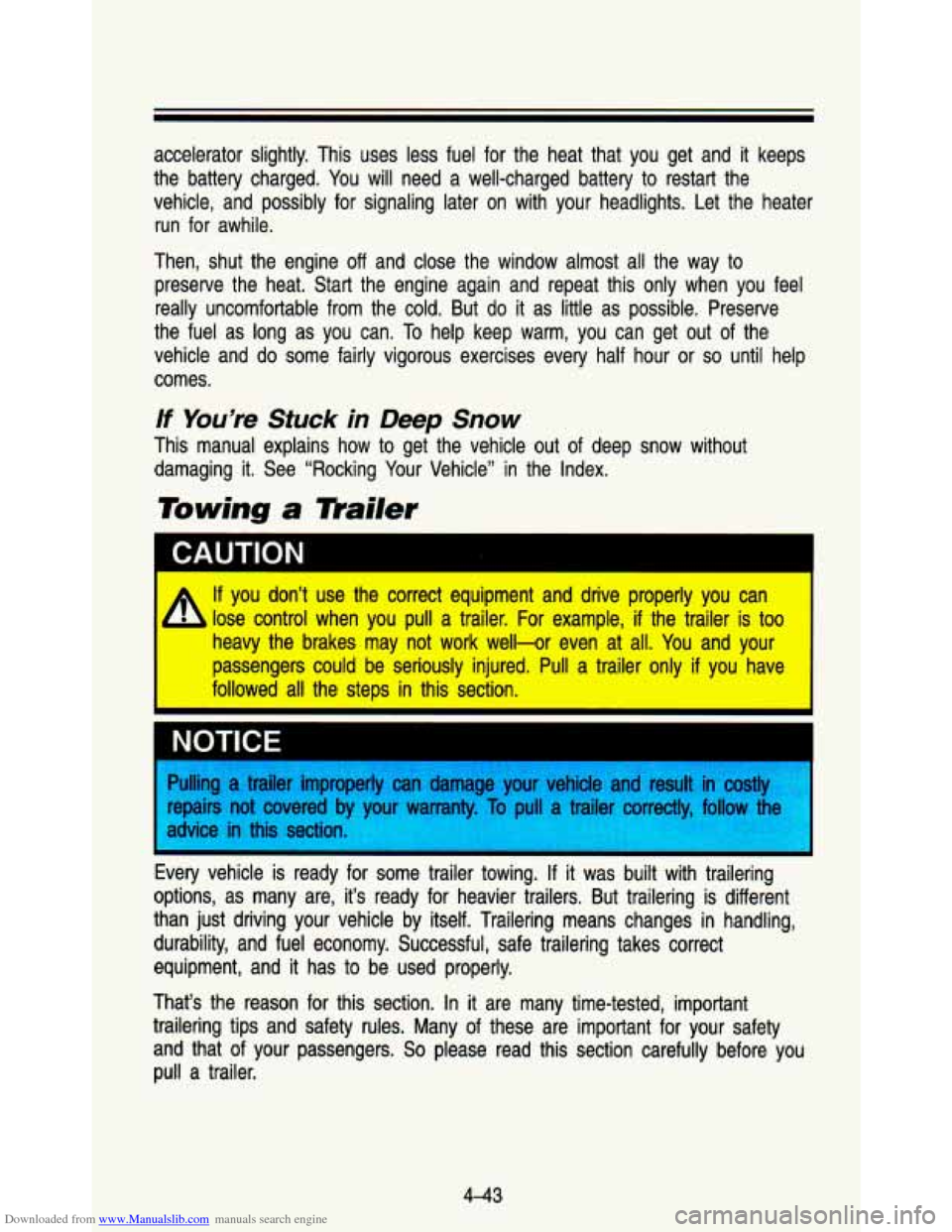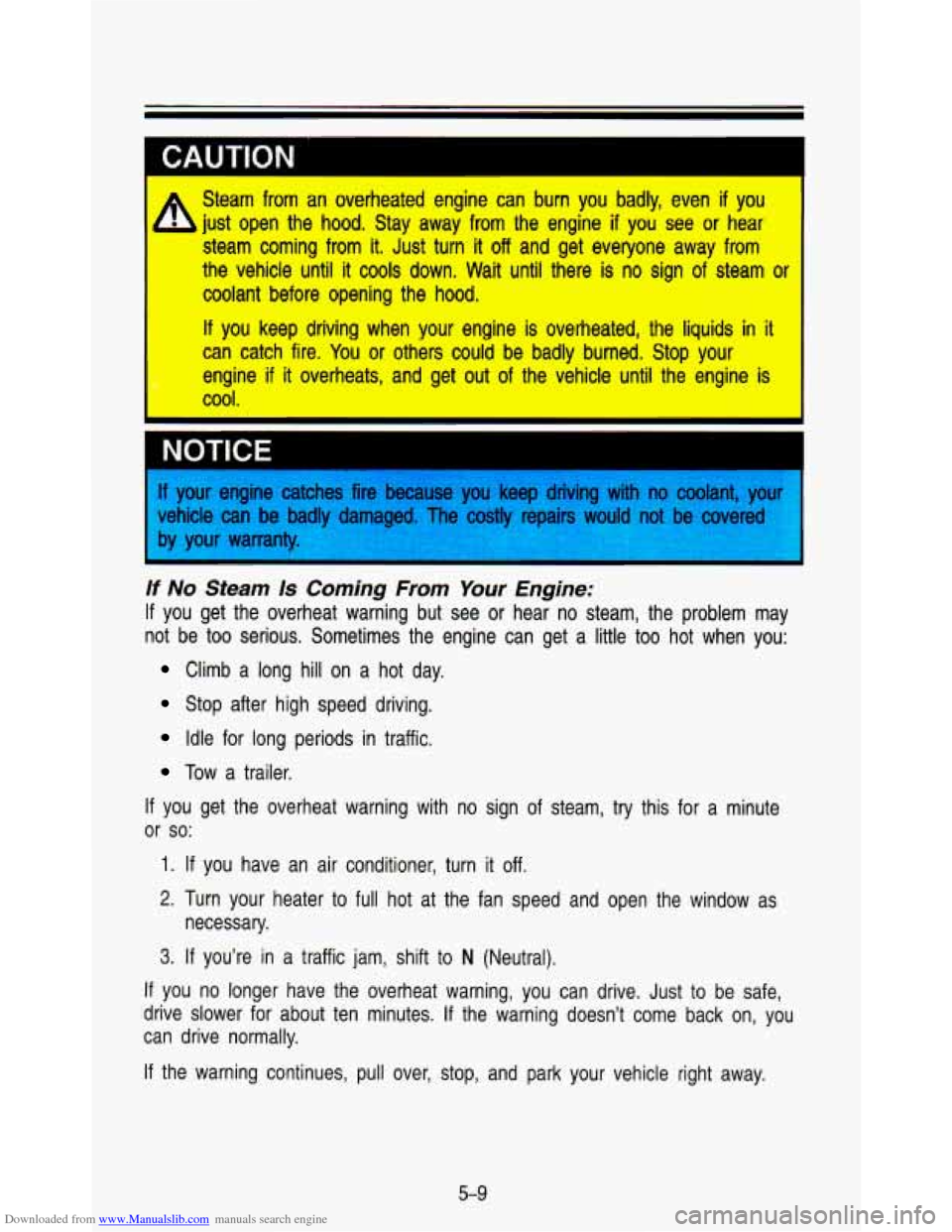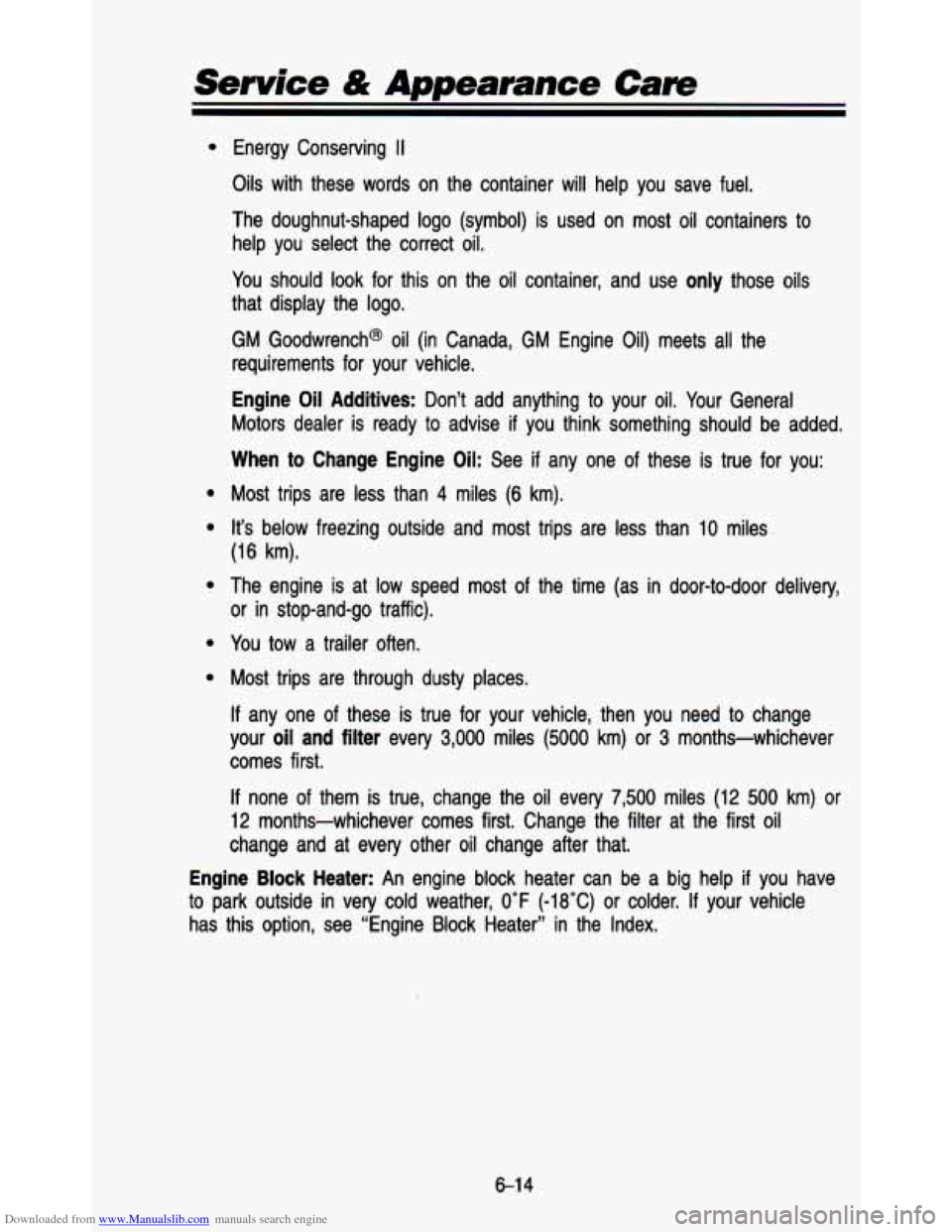Page 131 of 345

Downloaded from www.Manualslib.com manuals search engine HTR (Heater): Most of the air comes out near the floor. The rest comes out
from the defroster vents under the windshield and at the front\
side windows.
This is best for cold weather.
VENT The air comes out at the vents on your instrument panel and at your
front side windows. The air conditioner will not run. Adjust t\
he temperature
lever for warmer or cooler air.
BI-LEV NC: With this, outside air comes in through the heater floor vent and
the instrument panel vents.
If you move your temperature control lever
between cold and hot, cooler air will come out of the upper vents while
warmer air comes out of the
floor vent. This setting is useful in cool weather
with bright sunlight.
NORM NC: This setting cools the outside air. If you first used MAX NC, use
NORM NC as soon as the vehicle has cooled down, so outside air will be
going through your vehicle.
MAX NC: This cools the air the fastest. Move the other lever all the \
way to
Cold.
MAX A/C lets in only a little air from the outside. You can use MAX
NC at first when it’s really hot outside and you need to cool off quickly.
When the air conditioning or defrost is on, you may notice a slight increase
or decrease in engine .speed.
Rear Heater
You may have the optional rear heater. The three-speed fan switch is above
the radio. Slide the lever toward
HI for warmer air in the rear area. Move the
switch to
OFF to turn the system off.
~ PO654
3-7
Page 133 of 345

Downloaded from www.Manualslib.com manuals search engine does not get too hot. If the window still isn’t clear, turn the defogger on
again.
Scraping the inside of your rear window could cut and damage th-
defogger. Your warranty would not cover this damage.
A*A don’t put
decals there, you might have to scrape them
I
Engine Block Heater
If you use the optional engine block heater before starting yo\
ur engine, your
heating system will produce warmer air faster to heat the pass\
enger
compartment in cold weather. See “Engine Block Heater” in the Index.
Audio Systems
Your Dekoa audio system has been designed to operate easily and give
years of listening pleasure. But you will get the most enjoyment out of it,
if
you acquaint yourself with it first. Find out what your Delco@ system can do
and how
to operate all its controls, to be sure you’re getting the mos\
t out of
the advanced engineering that went into it.
CAUTION
Hearing damage from loud noise is almost undetectable until it is too
late. Your hearing can adapt to higher volumes
of sound. Sound that
seems normal can be loud and harmful to your hearing. Take
’ precautions by adjusting the volume control on your radio to a safe
sound level before hearing adapts to it.
To help avoid hearing loss or damage:
Adjust the volume control to the lowest setting.
Increase volume slowly until you hear comfortably and clearly.
3-9
Page 197 of 345

Downloaded from www.Manualslib.com manuals search engine accelerator slightly. This uses less fuel for the heat that yo\
u get and it keeps
the battery charged. You
will need a well-charged battery to restart the
vehicle, and possibly for signaling later on with your headligh\
ts. Let the heater run for awhile.
Then, shut the engine
off and close the window almost all the way to
preserve the heat. Start the engine again and repeat this only\
when you feel really uncomfortable from the cold. But
do it as little as possible. Preserve
the fuel as long as you can. To help keep warm, you ca
vehicle and do some fairly vigorous exercises every half
comes.
If You’re Stuck in Deep Snow
This manual explains how to get the vehicle out of deep
damaging it. See “Rocking Your Vehicle” in the Index.
Towing a mailer
In get out of the
hour or
so until
snow without help
If you don’t use the correct equipment and drive properly you \
can
lose control when you pull a trailer.
For example, if the trailer is too
heavy the brakes may not work well-or even at all. You and your
passengers could be seriously injured. Pull a trailer only
if you have
followed all the steps in this section.
I
NOTICE
Pulling a trailer improperly can damage your vehicle and result\
in costly
advice in this section.
pairs not covered
our
\a/arran+y. To pull a r correct‘ fnllow the
Every vehicle is reaay ior some trailer towing.
If it was built with trailering
options, as many are, it’s ready for heavier trailers. But \
trailering is different
than just driving your vehicle by itself. Trailering means chan\
ges in handling,
durability, and fuel economy. Successful,
safe trailering takes correct
equipment, and it has to be used properly.
That’s the reason for this section. In
it are many time-tested, important
trailering tips and safety rules. Many
of these are important for your safety
and that of your passengers.
So please read this section carefully before you
pull a trailer.
4-43
Page 213 of 345

Downloaded from www.Manualslib.com manuals search engine CALITION
I
Steam from an overheated engine can burn you badly, even if you
just open the hood. Stay away from the engine
if you see or hear
steam coming from it. Just turn it
off and get everyone away from
the vehicle until it cools down. Wait until there is no sign of steam
or
coolant before opening the hood.
If you keep driving when your engine is overheated, the liquids in it
can catch fire. You or others could be badly burned. Stop your
engine
if it overheats, and get out of the vehicle until the engine is
cool
m
NOTICE ~~ ~
I your engine catches fire because you keep driving with no coolant, yolrl
lehicle can be badly damaged.
Thrr costly repairs would not be covered
y your warranty.
If No Steam /s Coming From Your Engine:
If you get the overheat warning but see or hear no steam, the problem may
not be
too serious. Sometimes the engine can get a little too hot when you:
Climb a long hill on a hot day.
Stop after high speed driving.
Idle for long periods in traffic.
Tow a trailer.
If you get the overheat warning with no sign of steam, try t\
his for a minute
or
so:
1. If you have an air conditioner, turn it off.
2. Turn your heater to full hot at the fan speed and open the window as
necessary.
3. If you’re in a traffic jam, shift to N (Neutral).
If you no longer have the overheat warning, you can drive. Just to be safe,
drive slower for about ten minutes.
If the warning doesn’t come back on, you
can drive normally.
If the warning continues, pull over, stop, and park your vehicle \
right away.
5-9
Page 215 of 345
Downloaded from www.Manualslib.com manuals search engine c I
PO453
The coolant level should be at or above FULL. If it isn't, you may have a
leak in the radiator hoses, heater hoses, radiator, water pump or somew\
here
else in the cooling system.
mm I CAUTION
How to Add Coolant to the Coolant Recovery Tank
If you haven't found a problem yet, but the coolant level isn't \
at or above
FULL, add a 50/50 mixture of clean water (preferable distilled) and a proper
antifreeze at the coolant recovery tank. (See "Engine Coolant" \
in the Index
for more information about the proper coolant mix.)
5-1 1
Page 216 of 345
Downloaded from www.Manualslib.com manuals search engine 1 CAUTION
A Adding only plain water to your cooling system can be dangerous.
Plain water, or some other liquid like alcohol, can boil before the
proper coolant mix
will. Your vehicle’s coolant warning system is set
for the proper coolant mix. With plain water or the wrong mix, yo\
ur
engine could get too hot but you wouldn’t get the overheat \
warning.
Your engine could catch fire and you or others could be burned. Use
~ cold weather, water can freeze and crack the engine, radiator, heater
‘e and other parts. Use the recommended coolant.
I CAUTION
A You can be burned if you spill coolant on hot engine parts. Coolant
enough. Don’t spill coolant on a hot engine.
b contains ethylene glycol and it will burn if the engine parts are hot
Vwn the coolant in the coolant recovery tank is at or above FULL, start
your vehicle.
5-1 2
Page 250 of 345

Downloaded from www.Manualslib.com manuals search engine Service & Appearance Care
e
e
e
e
e
e
Energy Conserving II
Oils with these words on the container will help you save fuel.
The doughnut-shaped logo (symbol) is used on most oil contain\
ers to
help you select the correct oil.
You should look for this on the oil container, and use
only those oils
that display the logo.
GM Goodwrench@ oil (in Canada, GM Engine Oil) meets all the \
requirements for your vehicle.
Engine Oil Additives: Don’t add anything to your oil. Your General
Motors dealer is ready to advise
if you think something should be added.
When to Change Engine Oil: See if any one of these is true for you:
Most trips are less than
4 miles (6 km).
It’s below freezing outside and most trips are less than 10 miles
(16 km).
The engine is at
low speed most of the time (as in door-to-door delivery,
or in stop-and-go traffic).
You
tow a trailer often.
Most trips are through dusty places.
If any one of these is true for your vehicle, then you need to change
your
oil and filter every 3,000 miles (5000 km) or 3 months-whichever
comes first.
If none of them is true, change the oil every 7,500 miles (12 500 km) or
12 months-whichever comes first. Change the filter at the first oil
change and at every other oil change after that.
Engine Block Heater: An engine block heater can be a big help if you have
to park outside in very cold weather,
0°F (-18°C) or colder. If your vehicle
has this option, see “Engine Block Heater” in the Index.
6-14
Page 253 of 345
Downloaded from www.Manualslib.com manuals search engine 5. Grasp the top of the heater duct and pull down gently to remove.
.- -e
PO381
6. Remove the bolt from the engine cover bracket. Loosen the nut and
move the bracket out
of the way.
PO65 1 i9
6-1 7